- Home
- InDesign
- Discussions
- Re: Transparency Compliance with PDF/x-1a
- Re: Transparency Compliance with PDF/x-1a
Copy link to clipboard
Copied
Hello Folks,
I've been designing a book layout for a friend that will be printed using POD. Ingram Lightning Source through DrivethroughRPG is the company that is doing the printing. I have created a very intricate design that works for his RPG book that is 474 pages long. There is a lot of art and texture. It's a lovely book, and I'm very happy with it.
The problem is that I'm not very knowledgeable about printing in general. The specs provided mentioned nothing about transparency being an issue. Later, I discovered that transparency is a no-no in PDF/X-1a:2001, which is what the printer wants. However, the PDF file is LOADED with opacity shifts and art with transparent backgrounds. (By the way, InDesign gave me no warning about this when I exported to PDF/X-1a:2001!) The art needs to be faded slightly into the subtle textured background. To accommodate their no-transparency rule, I'd have to do some major overhauling on the file after weeks of work. I can see a route to still getting the effects I want without using transparency in InDesign/PDF, but it involves creating a page background for every page that has art with transparency, with the art flattened into the page background ahead of time in Photoshop rather than in InDesign. As you can imagine, this would get tedious very quickly! It would means using unique backgrounds for the art pages instead of master pages. Major headache!
So, my question is, are there any workarounds for this kind of thing? I have a message in to the printer for help also, but I thought I'd inquire here.
Michael
 1 Correct answer
1 Correct answer
To summarize the responses here ...
For reliable PDF print publishing workflows, PDF/X-4 is strongly recommended as the PDF subset standard to use. PDF/X-4 supports live transparency and ICC color management.
On the other hand, PDF/X-1a forces all transparency in your original content to be “flattened” into opaque objects and all color to be converted into DeviceCMYK. The flattening process often results in quality degradation with flattening artifacts including stitching lines. Conversion to Devi
...Copy link to clipboard
Copied
This is really something you should have asked BEFORE starting. PDF/X1-a is nothing short of archaic. It is more than 15 years old and there’s no place for it in a modern workflow. Many printers that ask for it are capable of handling X-4 files
I have no idea what “opacity shifts” means. By definition, everything gets flattened in X1a as well as converted to CMYK.
That out of the way, if the file is properly created and exported, it SHOULD print properly.
Copy link to clipboard
Copied
Thanks for the quick reply, Bob!
>>This is really something you should have asked BEFORE starting. PDF/X1-a is nothing short of archaic. It is more than 15 years old and there’s no place for it in a modern workflow.<<
Tell me about it. But, then again, I did ask ahead of time. The instructions provided said absolutely nothing about it. My error was in not being familiar with PDF/x-1a. However, in my defense, it took some major searching to even find out that transparency wasn't allowed. I only found out by reading that later PDF formats added transparency as a feature.
>>I have no idea what “opacity shifts” means<<
I mean setting the opacity of objects within InDesign to something other than 100%. It's under Effects. I set opacity to 85% for all text, and some artwork was set to as little as 40% in order to get the faded effect I wanted.
>>By definition, everything gets flattened in X1a as well as converted to CMYK. That out of the way, if the file is properly created and exported, it SHOULD print properly.<<
I agree, which is why I'm confused and posted here. I exported the file from InDesign precisely as the printer indicated. There were no Preflight errors or other indications that something went wrong. I viewed PDF extensively before sending to the printer, and everything looks exactly the way I wanted it to. If it isn't the export going off somehow, then I suspect they are objecting to the artwork with a transparent background (placed as unflattened PSDs). If it's that, that would be the easiest thing to fix.
Thanks for the reply. Let me know if you have any other ideas.
Michael
Copy link to clipboard
Copied
If you actually chose X/1-a there is no transparency in the file.
Did you change anything from that preset at all?
Copy link to clipboard
Copied
Yes, but it was what the printer requested. "Optimize for Fast View" needed to be checked. And they requested .125 bleeds on every side except the inside of the sheet. No slug.
Michael
Copy link to clipboard
Copied
That setting shouldn’t matter and certainly has nothing to do with printing. It just forces the first page to render quicker in a web browser.
Copy link to clipboard
Copied
I am using Export to PDF rather than Publish. Would that make a difference?
Michael
Copy link to clipboard
Copied
Publish has absolutely nothing to do with PDF production!
- Dov
Copy link to clipboard
Copied
To summarize the responses here ...
For reliable PDF print publishing workflows, PDF/X-4 is strongly recommended as the PDF subset standard to use. PDF/X-4 supports live transparency and ICC color management.
On the other hand, PDF/X-1a forces all transparency in your original content to be “flattened” into opaque objects and all color to be converted into DeviceCMYK. The flattening process often results in quality degradation with flattening artifacts including stitching lines. Conversion to DeviceCMYK assumes that whoever directs you to convert to CMYK actually tells you which CMYK!!! US Web Coated SWOP? FOGRA? Which? If this isn't specified by the print service provider, expect color “issues” when printing.
Ironically, virtually all RIPs / DFEs (Digital Front Ends) sold over the last ten years support live transparency, color management, and PDF/X-4. It is the fear and ignorance of many print service providers that causes them to either require or request PDF/X-1a. Luddites!! In fact, RIPs / DFEs that support PDF/X-4 will yield superior output with PDF/X-4 as opposed to PDF/X-1a generated from the same original content that had live transparency. The PDF file will generally be smaller and RIP faster as well!
All that having been said, if you are not able or willing to find a print service provider who has entered the 21st Century, if you carefully prepare a PDF/X-1a file, you may get acceptable results if and only if the print service provider provides you with the information as to (1) what the CMYK color space they use is and (2) what the resolution is that they print at. Flattening should be done at a resolution close as possible to that of the rendering device (much of flattening prematurely converts text and/or vector objects into raster images if one or more of the overlapping objects in transparency are raster images).
And optimize for quick web view is totally and utterly irrelevant for printing in any way! (Tends to confirm ignorance of whoever is providing these specifications!)
Good luck!
- Dov
Copy link to clipboard
Copied
Waiting on a response from the printer. I'm as mystified as everyone else as to why they want such an outdated PDF format. Hopefully, they'll be able to explain better what actually needs to be changed. The print company, DrivethroughRPG.com, was chosen by my employer, the friend for whom I'm doing this, and it is a website especially for role-playing games, using print-on-demand. It's the main hub for self-publishing RPGs in the gaming industry, and there really are no other options. He could go to other printers, but then it either wouldn't be POD or wouldn't have the industry-specific exposure his game needs. Sad, but true, that they are so far behind the times, big as they are in this niche. I guess they want books with bad (or limited) design on their website. Perhaps they get kickback from Wizards of the Coast to keep their books ugly! ![]() I'm kind of pissed about it because I was so ready to be done with this book and see it in print.
I'm kind of pissed about it because I was so ready to be done with this book and see it in print.
CMYK was resolved along with ink coverage specs (240%) and resolution (300ppi). None of that appears to be the issue.
Thanks for your help.
Michael
Copy link to clipboard
Copied
I suspect that in many cases, the print service provider lazily copies the specs for their PDF files from other websites which copied them from yet other websites, etc. with no regard for whether what they are copying makes all that much sense.
What is very sad is that there is very little continuing education for or that is taken advantage of by printers. Whatever they learned when they entered the industry, they stick with even if such “education” is obsolete.
In other cases, in discussions I have had with some printers, the preference for PDF/X-1a (and other aberrations such as requiring all text to be “outlined” instead of being rendered with actual fonts), I have been told that they prefer such old formats because they feel that it is easier “to blame the customer if printing doesn't come out right” if they relay on the RIP / DFE to properly render transparency and deal with color management. For an industry that is in the throes of dramatic downsizing and adjustment (much of what used to be printed isn't being printed anymore and what is being printed is typically much shorter run, but very graphically complex!), such attitudes are not conducive to attracting new or maintaining existing customers! Again, real sad!
- Dov
Copy link to clipboard
Copied
The problem is that I'm not very knowledgeable about printing in general...
they feel that it is easier “to blame the customer if printing doesn't come out right
The customer in this case readily admits to knowing little about printing, but is buying a POD service that by definition is a DIY prepress process. He values price over quality—there's no proof, customer service rep, or press check. Why would any sane printer be willing to take the blame for color or resolution problems in a workflow like that?
Copy link to clipboard
Copied
Well said.
IOW, you get what you pay for.
Copy link to clipboard
Copied
Fifteen years ago I made a fine living providing highend print design and production. One day I made the mistake of bringing a customer on a press check and she couldn't understand why I just wasted half her day. She could careless about the subtitles of ink densities and managed color, and in fact couldn't see the differences that were obvious to me. I moved on to web design.
It's easy to see the benefits of RGB-PDF/X4 in a world where there are hand-holding CSR's, prepress departments, contract proofs, and press checks, but that's so 90s. We might think that only an ignorant luddite would require PDF/X-1a, but it's quite common in the automated print world where there are some very large and sophisticated players. If X-1a is causing problems in Ingram's print flow it hasn't affected their bottom line.
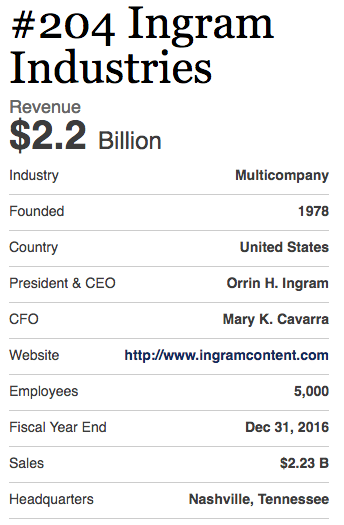
Copy link to clipboard
Copied
>>The customer in this case readily admits to knowing little about printing, but is buying a POD service that by definition is a DIY prepress process. He values price over quality—there's no proof, customer service rep, or press check. Why would any sane printer be willing to take the blame for color or resolution problems in a workflow like that?<<
You are conflating me and my client and making assumptions. I definitely don't value price over quality. I spent weeks making this book look amazing when I didn't have to, precisely because I'm an artist and have high standards. Most of the other books I see printed on the site are terrible by comparison. If it were up to me, I wouldn't be using this service for any books I created for myself, but then I wouldn't be working in the same field, now would I? I readily admit not knowing a lot about the printing process, but really that is more of an experience rather than knowledge thing. I know about InDesign, color and ink coverage, plus I'm smart and a quick study, and I have 15 years experience in graphic arts. Ironically, this problem did not occur because of my admitted lack of experience. It occurred because of decisions that were not made by me. Their instructions did not after all say DO NOT USE TRANSPARENCY.
Even so, the decision to use their service is almost made for you if you're self-publishing an RPG based on a Kickstarter campaign. Did you read this?
"The print company, DrivethroughRPG.com, was chosen by my employer, the friend for whom I'm doing this, and it is a website especially for role-playing games, using print-on-demand. It's the main hub for self-publishing RPGs in the gaming industry, and there really are no other options. He could go to other printers, but then it either wouldn't be POD or wouldn't have the industry-specific exposure his game needs."
They are virtually the only game in town, pardon the pun.
By the way, the company in question does in fact take responsible for color problems. The say so in their instructions. It's probably because they know there are going to be people who struggle with their archaic limitations, and because no printing or upload means no money for them. It's a different kind of business model that is quickly becoming the new standard, for better or worse. In any case, I have 'an expert' from the company examining my file to see what the problem is, so thanks for your advice.
Michael
Copy link to clipboard
Copied
There is a lack of proper communication and understanding here about what constitutes transparency. The fact that the text is not flattened or rasterized is not indicative of live transparency at all. Sounds like a case of the blind leading the blind.
If you want to post the file somewhere I’m sure you have several people here ready and willing to have a look at it.
Copy link to clipboard
Copied
>>If you want to post the file somewhere I’m sure you have several people here ready and willing to have a look at it.<<
Thanks for the offer, but the file is 474 pages long. It would have to be a link to Google Drive. I doubt I could upload it here.
Michael
Copy link to clipboard
Copied
Ingram Lightning Source through DrivethroughRPG is the company that is doing the printing....
Did you read this?
Yes, but they are sub-contracting to Ingram, so I would look at Ingram's POD guide.
You've confused live and flattened transparency. You can use transparent objects, but the PDF/X-1a standard forces those objects to be flattened. Flattening keeps the appearance of transparency by dividing the objects into multiple opaque objects. The 3 transparent objects in my #14 become 7 opaque fills.
I definitely don't value price over quality. I spent weeks making this book look amazing when I didn't have to, precisely because I'm an artist and have high standards.
Then you can't use a POD service or you have to be willing to compromise. Get a quote from a traditional highend offset book printer for 474 pages where the minimum run will be 1000+ and you will start to value the POD price
By the way, the company in question does in fact take responsible for color problems. The say so in their instructions.
PDF/X-1a bakes in the CMYK color values. No automated service requiring X-1a will adjust the color values you send.
But this is POD, which has the huge advantage of being able to print one copy at a reasonable price. You can effectively run a press proof of the entire book or a section before investing in larger quantities.
Copy link to clipboard
Copied
In any case, I have 'an expert' from the company examining my file to see what the problem is, so thanks for your advice.
Even though this Preset's name is PDF/X-1a:2001, the export would not pass an X-1a preflight test because I changed the Standard and Compatibility:
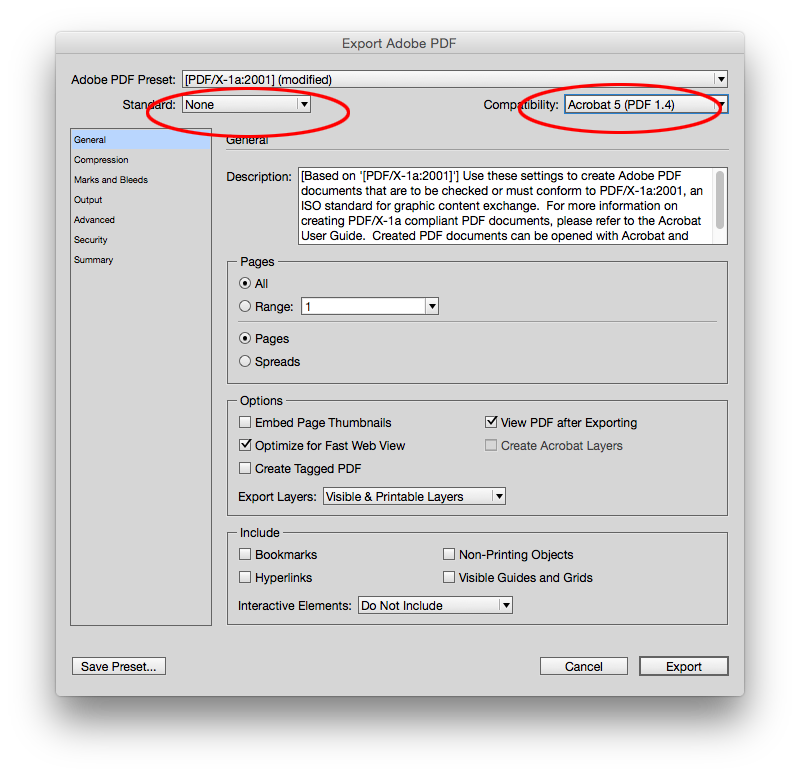
Also, you have to export Pages or the printer will not be able to impose the book, so Spreads would get rejected:

Copy link to clipboard
Copied
I think you may have hit the nail on the head, Rob. The instructions given me indicated that the version should be changed to Acrobat 6 (PDF 1.5). Apparently, this modified the export sufficiently that flattening was not happening. When I left that setting alone, immediately the export was much slower and included the critical word 'flattening' in it as it was working. After creating the PDF, I was able to observe what I believe is called 'stitching'. It looks more like scratches over the surface of the picture to me. Also, the PDF runs much much slower in Acrobat.
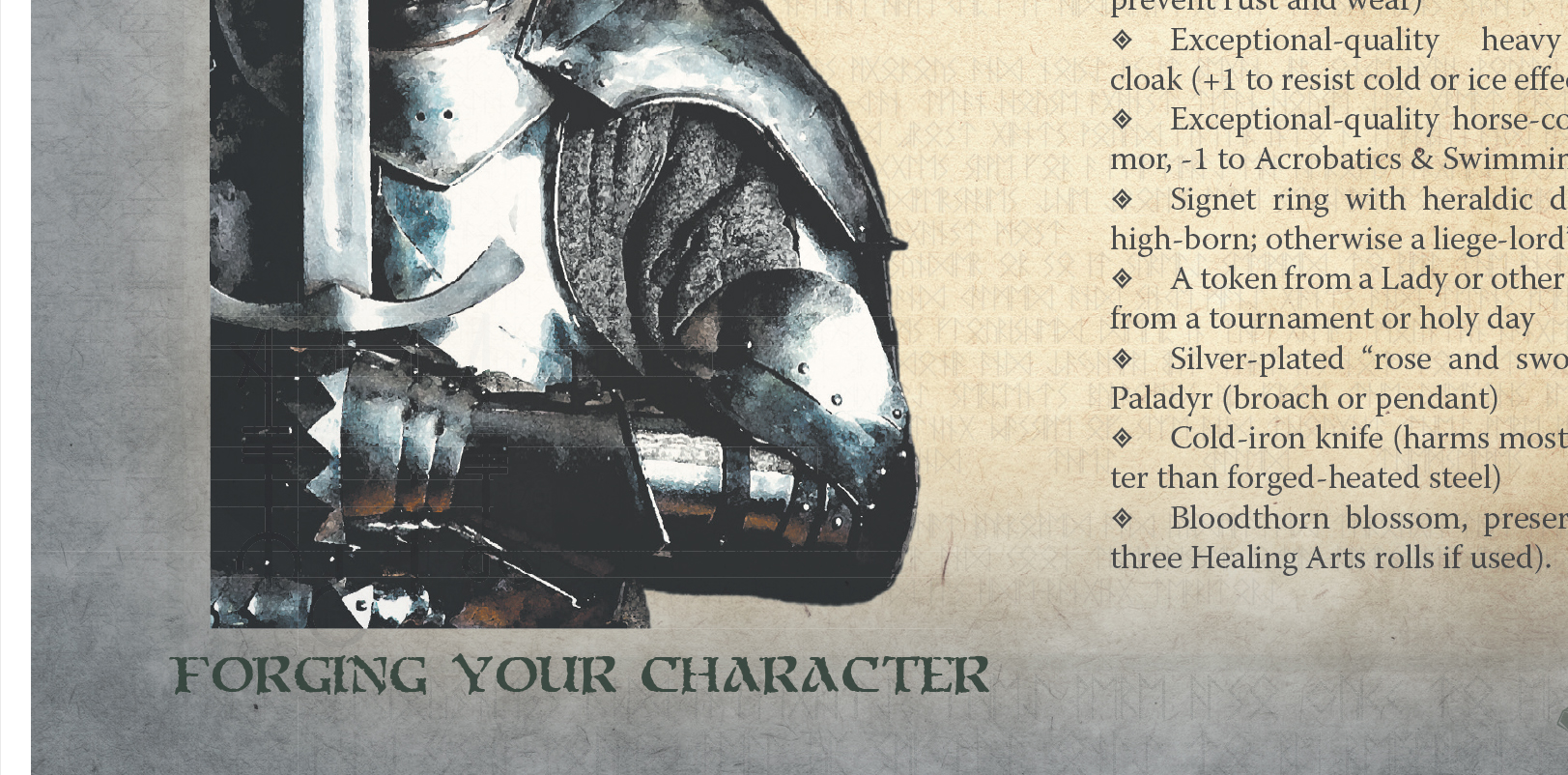
The attached photo shows what I think might be stitching in the lower left of the knight photo.
Also, here are the instructions from Lightning Source.

I think I can produce a file that is valid for them now, push come to shove, but I'm still going to see what this guy suggests before proceeding. I'm not sure I can live with the scratches on the photos or not.
Michael
Copy link to clipboard
Copied
I asked you initially about changes and you never answered it.
Anything past Acrobat 4 will keep transparency live in a PDF export.
Copy link to clipboard
Copied
>>I asked you initially about changes and you never answered it. Anything past Acrobat 4 will keep transparency live in a PDF export.<<
Sorry, Bob, must have missed that comment somehow.
Rob: Yeah, DrivethroughRPG specifically stated that the version be changed to Acrobat 6 (PDF 1.5), not Lightning Source. See attached instructions in above post. But, now, they're saying that they're rejecting the file because of transparency, which were preserved by their very instructions. Blech - What a mess! No wonder I was confused. Their instructions are crap.
Frankly, I don't know how I could flatten the whole file anyway. I used the regular PDF/x-1a settings (with no changes) on a 50 page section of the book, and it took 30 minutes to complete, it flattened everything, and the resulting file is 500mb!, whereas the complete book as Acrobat 6, preserving transparency, is only 166mb.
>>That's actually an out and out contradiction in someone's instructions. PDF/X-1a must be PDF 1.3 or older. There is no middle ground, it just can't be.<<
It indeed appears so.
Michael
Copy link to clipboard
Copied
Why don't you try to contact Ingram directly?
My take on automated services requiring X-1a is they want to avoid color gamut problems and PDF/X-1a forces the client to see the color in the narrower CMYK gamut. All they have to do is check the standard to know that happened. Clearly Ingram runs state of the art equipment, so they would be able to print a PDF/X-4. Maybe if you contact tech support they will make an exception.
These colors are unprintable and a human would catch the problem but an algorithm wouldn't.
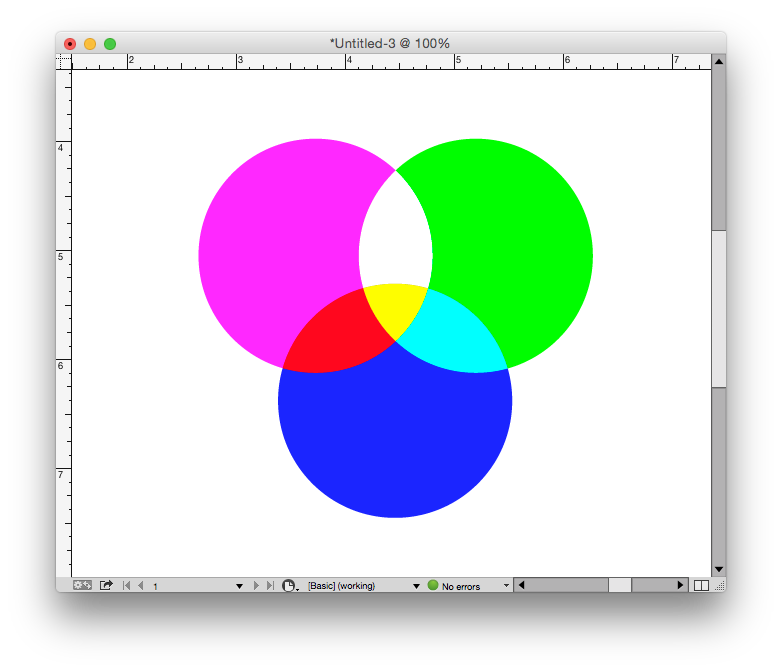
The conversion will shift the color to something like this.
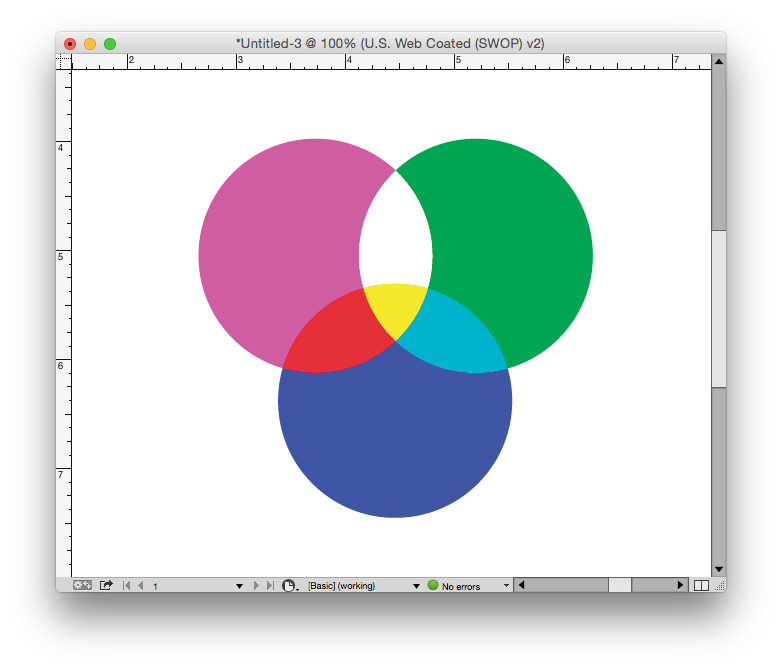
Copy link to clipboard
Copied
Also, here are the instructions from Lightning Source.
I've been assuming you are dealing with the Ingram Content group

Their Ferurary 2017 guide asks for for the PDF/X-1a standard—there's no mention of changing the compatibility to Acrobat 6, which would no longer meet the X-1a standard. Is that change to the guidelines coming from DrivethroughRPG?
Again here is Ingram's guidelines see page 11
https://www.ingramcontent.com/Documents/LSI_FileCreationGuide.pdf
Stitching is a concern with flattened PDFs, but they are a low resolution artifact (monitor displays) and wouldn't show in high resolution output. A press wouldn't be capable of printing a mark that small —the halftone screen would obscure it.
You should definitely invest in a single copy and use it as proof before ordering large quantities.
Copy link to clipboard
Copied
Incidentally, I'm pretty sure that some of the graphics are not being flattened, by the way. In the PDF, I can search on text used in the background (that is faded down so light that it's very subtle). The backgrounds were a layered Illustrator file placed into the master pages. They included text, which did not get flattened in the final PDF. Now that I think about it, this is making me wonder if the export is not working correctly.
Michael
-
- 1
- 2
Get ready! An upgraded Adobe Community experience is coming in January.
Learn more

